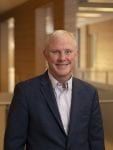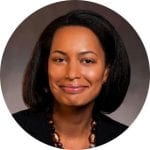
Photo by Flickr user Brent Moore, CC BY-NC 2.0
As program director for health equity at the Massachusetts Association of Community Development Corporations (MACDC), part of Elana Brochin’s job is developing training programs for community development staff, planners, and housing advocates.
The training always starts with language—laying the groundwork for a common understanding of health concepts.
“The very first thing we do is introduce a number of terms,” Brochin says. “What is health equity? What are health disparities? What do we mean by ‘health care’ versus ‘public health’? These are not necessarily intuitive to people outside the public health space.”

Elana Brochin
Before joining MACDC in 2019, Brochin’s career path had been solidly in public health research and policy. Her role at MACDC is new, and it’s a sign of the growing value community development corporations (CDCs) see in gaining health expertise. “The fact that they were creating this position indicated a real acceleration of the thinking that was happening in the community development space,” Brochin says.
Long at the forefront in addressing the conditions of places where we live, work, and play—now seen as social determinants of health—CDCs are increasingly looking to health professionals to strengthen their engagement with health organizations and funders.
The Build Healthy Places Network found in a 2020 survey of CDCs that lack of staff capacity and in-house health expertise are barriers to engaging with health care organizations, even though the majority of CDCs want to do so. And a 2017 report by NeighborWorks America and Cityblock Health showed that the vast majority of 242 CDCs surveyed conducted “activities at the nexus of health, housing, and community development” and engaged partners to do so, but the report also indicated gaps in their knowledge of health-focused strategies.
But hiring is happening. Last year, MACDC’s annual member survey (covering 2019 activity) for the first time included questions on whether community development corporations had health experts on their staff or boards. Of 57 respondents, roughly one-third had at least one staff member with a health background and about one-third reported having a health expert on their board.
Cross-sector hiring is occurring in the opposite direction, too, with community development experts increasingly landing within hospitals, public health organizations, and even health insurers.
Shelterforce spoke with people across the U.S. who have navigated this new territory. In either direction, for those changing sectors it can be a lonely leap, bringing a learning curve from establishing shared language to navigating different organizational cultures—but also a satisfying experience that opens up fresh opportunities to make change happen.
Addressing the Intersection of the Built Environment and Health

Angela Mingo
Angela Mingo brought city planning expertise to the newly created role of director of community relations at Nationwide Children’s Hospital in 2007. Early on in her career with the Columbus, Ohio, hospital, Mingo worked with civic associations and area commissions to support community engagement, and now she oversees the housing prong of an initiative focused on social determinants of health. She’s forged a partnership with a local faith-based CDC to develop and rehabilitate housing and provide job training to local residents, and collaborates closely with a community development financial institution (CDFI) to fund housing development and with a property management company to maintain the hospital-owned housing.
[Related Article: Getting Ahead of Gentrification in the South Side of Columbus]
Plenty of translation comes into play when introducing housing finance to people who work in health care.
“There can be a very broad learning curve when you start to get into the technicalities of financing affordable housing,” Mingo says. “When you’re coming from the space of health care, understanding the difference between low-income housing tax credits that are ‘4 percent deals’ and ‘9 percent deals’ certainly requires some time and expertise in the room to be able to translate.”
Different sectors often have shared priorities but view them through their own lenses, she says. City governments may be moved to address social determinants of health for economic development and neighborhood stabilization, while a hospital is assessing the same factors to support population health.
Mingo’s community relations team has added more urban planners, which she sees as a natural way to address the intersection of the built environment and health. “We now know, under this lens of health, that when you have walkable communities, you have sidewalks, you have green space, traffic calming—these are all factors towards health. So it makes a lot of sense to have urban planners involved in health and wellness because the two go hand in hand, and I think there’s greater appreciation for not doing work in silos.”
From Medicine to Housing and Back

Kamillah Wood
Pediatrician Kamillah Wood crossed sectors specifically to be a translator. As a clinician in community health, she saw that her patients’ health issues couldn’t be readily fixed at the doctor’s office if families were facing life problems like imminent eviction or food insecurity. Wood transitioned into public policy—first transportation, then housing—to be part of addressing these social determinants of health further upstream. “Let me learn about affordable housing, I thought—what are they trying to do, what’s the disconnect, and how can I be a translator across those sectors?”
Wood saw that in health care, people viewed housing mainly as public housing projects, while in the housing sector, she learned “all these differences between subsidized, vouchers, project-based Section 8, all these complexities.” When she landed back at a health-oriented organization, Children’s Health Fund, in 2019, she was equipped to translate. “Back in the health space, discussing housing, I helped them understand that it’s not monolithic. You have to be in it to see how complex and layered the diversity of housing options is.”
And conversely, she says, community development corporations tend to see health systems as a monolith. That can blind them to the many types of health entities that might yield funding and partnership options. In her work at Stewards of Affordable Housing for the Future (SAHF), she recalls, “I had to work to help our affordable housing developers to think beyond hospitals and health systems. There was this assumption that hospitals have this money that they’re ready to funnel into community development and housing, but it’s not always the case, or the business proposition hasn’t been there. But they could look at other players—public health departments, Medicaid payers. Again, health is not a monolith. It’s complex.”
Wood echoes Brochin on the need to “level set” language understanding. In multi-sector meetings, she sets rules about explaining or avoiding acronyms. “It’s important to have people feel empowered to say, ‘I don’t know what you’re talking about.’ And this doesn’t happen unless whoever’s leading sets it up as a norm,” she says. “It seems very elementary, but I find it very critical to have these norms to avoid misunderstandings.”
Exercises in Translation

Andy McMahon
Andy McMahon joined the national insurance giant UnitedHealthcare in 2017 as vice president of health and human services policy after 10 years at the Corporation for Supportive Housing. He agrees with Wood and Brochin: “I spend a chunk of my time just interpreting between systems,” he says.
McMahon is a “deal-finder and partner-finder” working to identify housing partners and affordable housing investment opportunities across the U.S. In his work, opportunities for cross-sector misunderstandings abound.
One example: “MLR,” which in Medicaid stands for medical loss ratio. “I probably say ‘MLR’ 50 times a day,” he says, “and what it means in plain English is, ‘Can we use Medicaid to pay for it or not?’” Other tricky terms include “CMO”—“Lots of people don’t know about chief medical officers”—and the acronym for Low-Income Housing Tax Credit (LIHTC). “Housing people will say, ‘I got LIHTC, HOME dollars, and this and that,’ and the health executives are saying, ‘Wait, what’s lie-tech?’” And that’s before even explaining tax-credit technicalities.
Language barriers aside, McMahon’s partnership-wrangling helps foster collaborations like his organization’s recent $100 million investment in affordable housing in partnership with SAHF and the National Affordable Housing Trust. The project is expected to create more than 1,000 new homes for families and seniors in locations across the U.S. and fund resident services such as onsite clinics or service coordinators. Tapping SAHF’s evaluation capacity, they’ll be able to track outcomes for residents.
Building a Financial Institution’s Public Health Knowledge
Crossing sectors also means adjusting to different ways of measuring results.

Hanaa Hamdi
Hanaa Hamdi, director of health impact investment strategies and partnerships at New Jersey Community Capital (NJCC), came to the CDFI in 2019 after public health roles in academia, community development, and government. Hamdi has helped NJCC forge partnerships with major health institutions to rehabilitate affordable homes and support down payment assistance.
“Language in public health is pretty technical,” she says. “It’s a science, and it often requires someone who’s in the field to translate to common use.”
In an early conversation at NJCC about social impact and using valid measures and assessment tools, the CDFI’s concept of “validation” differed from hers. “From the organization’s point of view, it means this has been done more than once, there is a culture of doing this—so that’s internal validation. In public health, ‘validation’ has a completely different meaning, requiring a rigorous academic process. There was this inherent conflict in how we understood this one thing.”
So, she says, “I paused and began to ask questions: ‘What does this mean to you, what does it mean in public health—and how can we develop a shared language?”
Hamdi has been steadily honing the capacity to bridge such gaps. To build in-house knowledge of public health and health care policy, she creates mini glossaries, delivers formal and informal training, and shares public health literature. At the same time, externally, she educates health institutions in the many and varied ways they can invest.
Mismatches in Size, Power, Time Frame
One cross-sector partnership barrier noted in many conversations is the size and power differential between community development corporations and health institutions.
“Everybody knows their local hospital, but not everyone will be able to name all their different CDCs and who they serve. So that’s another disconnect, getting on one another’s radars,” says Brochin.

Brian Rahmer
Brian Rahmer, a health equity strategist and consultant who has moved among the worlds of health care, community health, and housing, observes that a competition and scarcity mentality leads small CDCs to run one-by-one to large health institutions for funding, when they might gain more as a group.
At Enterprise Community Partners, where he was vice president of health and housing from 2018 to 2020, Rahmer helped build a network of affordable senior housing organizations before seeking hospital funding. “Aggregating their power allowed us to create a much more robust engagement with a major hospital system in Baltimore City,” Rahmer says. “The alignment among the ‘housers’ was the basis for shifting the health care sector into understanding the value of working with them.”
Wood points out another crucial mismatch between housing and health: time frame.
“I’ve learned that housing developers think very long term. When they’re building affordable housing properties, they’re thinking 20, 30 years out, across a generation,” she says. “Health care gives two- or three-year grants. This is not amenable to real solutions. It’s not like a randomized trial where you get your data in a year or two; social impacts take a much longer time.”
‘There Was No Translation for Me to Do’
For Melissa Jones, the leap from community development to public health could hardly have felt more natural. Her career had spanned anti-poverty work, city government, and neighborhood planning before she became executive director in 2015 of the Bay Area Regional Health Inequities Initiative (BARHII), a coalition of 11 county public health departments.

Melissa Jones
“I came into a public health coalition focused entirely on things that impact health that aren’t health care,” Jones says. “We were talking about, what are the fundamental things that will shape health and health equity in the next decade? And the No. 1 thing people said was housing and housing affordability. So there was no translation for me to do; people already saw it and knew it.”
Any gaps to bridge, she says, were more in what to do about it. “Public health folks are generally public administrators,” she says. “And public policy sets context, but how we apply it is what matters for communities. And so when I came in, they were looking to go into the ‘how.’”
BARHII’s regional approach and facilitation of partnerships with local community advocates helped win strong anti-rent-gouging legislation. Jones cites that as an example of the power of marrying community organizing strength with public health’s population-scale approach and information-sharing power. The effort began with a housing stability brief co-written with the Federal Reserve Bank of San Francisco that alerted elected officials to the acuteness of the housing crisis and how they could play a role in solutions.
When COVID-19 hit the Bay Area, that anti-rent-gouging success made it easier for organizers to get eviction moratoriums passed quickly, with local public health directors’ support.
‘A Little Like a Unicorn’
Bringing expertise from one sector to another often means being a pioneer, the first to navigate a newly created position and the lone translator between groups.

Amy Reigel
In 2018, Amy Riegel became the first director of housing at CareSource, an Ohio managed-care organization that has invested deeply in housing initiatives. (Managed-care organizations are health providers who aim to provide cost-effective medical treatment.) Previously, she worked in a nonprofit community action agency and the City of Dayton’s planning and community development department.
“Sometimes I’m an island of one, the only person in the room looking at it the way I’m looking at it,” Riegel says. “And that can be really difficult. You have to have a person who’s willing to voice their lens, when all the other voices in the room might be saying something completely different.”
Riegel observes that community development corporations often are surprised by the strict regulation of health insurance institutions. “Medicaid has to approve any type of benefit we want to give our members. There’s a lot of process,” she says. “It can be frustrating to a nonprofit who says, ‘You guys have all these resources. Why does it take you so long to do something so simple?’ We want to make sure we’re following all the rules, getting all the approvals, so we don’t misstep and scuttle a good initiative by not checking a box.”
Her current role involves connecting other internal teams with residents of the affordable housing CareSource has financed—for instance, having the IT team help implement new internet capability—as well as finding common ground with CDFIs and housing developers. “There could be places where our worlds intersect that we just haven’t found yet,” she says. “This space is still very new. We don’t know what we don’t know.”

Sarah Norman
At Baltimore’s Sheppard Pratt, Sarah Norman came in in 2019 as chief of community development after working at NeighborWorks America, and before that, in federal and city government.
Norman says, “In a lot of rooms, if I’m in a health world, I’m bringing that housing and community development perspective; and if I’m in the community development world, I’m bringing the health perspective. And so I’m always looking to flip whatever script is in the room.”
She hasn’t seen many peers hired within hospitals, though she is hopeful that’s changing. “I would like to say it’s a trend,” she says. “But I still feel a little like a unicorn.”
Norman has observed some philosophical differences on her multi-sector path. “One of the things I’ve learned is community development, as opposed to health, focuses on a positive. Rather than finding the pathology, you find the positive outcome. That’s definitely something community development brings to this conversation,” she says. “And I think the health world is moving in that direction too—that it’s not just illness, it’s healing.”





Dear Sandra, Thank you for this well-researched and thoughtful article. Until 2019, I worked as the Vice President for Health and Community Development at Preservation of Affordable Housing, based in Boston. I came from the health world so I thought (incorrectly) that I could establish useful bridges between affordable housing and health organizations relatively quickly . I still think there are important relationships to be developed, particularly around social impact investing, but the barriers are impressive (or depressing) as you outlined in your article. I now live in Sarasota, Florida but maintain an active interest in this area. Thanks again, Cathy Dunham
Hi Cathy — Thanks for your kind words and thoughtful comments. There are indeed plenty of barriers, but in working on this story I got a sense that things are changing, if slowly. It was inspiring to talk with so many folks out there chipping away at the obstacles.
Congratulations on your new role at Shelterforce!